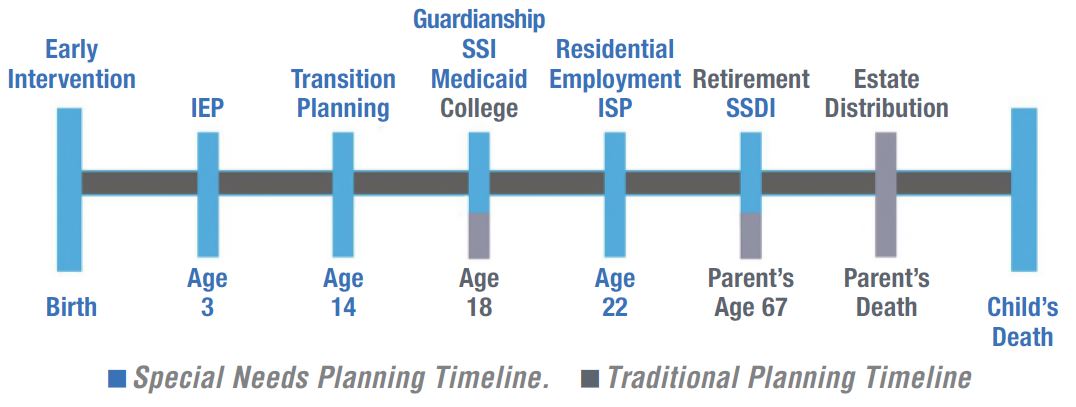WHILE WE RECOGNIZE THAT EACH FAMILY'S CIRCUMSTANCES ARE UNIQUE AND OUR BUSY LIVES ARE OFTEN COMPLICATED, HERE ARE A FEW PRACTICAL AND ACTIONABLE TIPS TO HELP YOU DEVELOP A PLAN.
THE SPECIAL NEEDS PLANNING TIMELINE
When your child receives a diagnosis, regardless of their age, your life will most likely begin on a different course than you had anticipated. To help you chart a path for all the members of your family's future, we developed the Special Needs Planning Timeline™.
The timeline will provide you with an overview of the key planning pressure points in the lives of all your family members. For example, finding the time when your mortgage will be fully paid and/or when you might begin to receive social security benefits on the timeline, will help you to visualize the stage of life for your child with special needs. You may not know the details of your financial situation at that time, but you can start to build a framework and budget for the future.
PLANNING TIPS TO THINK ABOUT AT EACH STAGE
Birth to age 3 – All in the Family: While it may sound odd coming from a financial professional, our first piece of advice to new parents is to focus on your child. When a child receives a diagnosis at birth or an early age, it is key for parents to focus their energy on their child's and their family's needs.
Early intervention (EI) services are individualized and family-driven; take advan
tage of this time to build a framework for the future. Initial steps to focus upon include:
- Plan for catastrophic events. Create a basic estate plan and include a special needs trust. Purchase life and disability insurance.
- Complete a Letter of Intent (LOI). The
LOI contains the details of daily living and specific instructions necessary to care for your child. This is information a caregiver needs to have just in case the unthinkable happens. Download a fillable Letter of Intent at info.spe- cialneedsplanning.com/en-us/parents-guide-to-the- special-needs-letter-of-intent
Chart 1. The Special Needs Planning Timeline

Reprinted by permission from The Special Needs Planning Guide: How to Prepare for Every Stage of Your Child's Life, by John W. Nadworny, CFP®, ChFC, MBA and Cynthia R. Haddad, CFP® Copyright © 2007 by Paul H. Brookes Publishing Co., Inc
- Learn who provides the services and supports your child requires, what agencies are involved and who pays for them. A helpful resource: Talking the Talk: Terms and Acronyms Frequently Used in the Disability Community (info.specialneedsplanning.com/blog-1/do- you-talk-the-talk).
- Network. The personal and professional relationships you form when your child is young will many times deepen and endure throughout both your lifetimes.
Ages 3-14 – Welcome to School: When your child enters school, it may feel as though you have lost control and the professionals have taken over. In addition to advo
cating for an appropriate educational program and facilitating a social life for your child, there are subtleties to be conscious of.
- It is important to identify allies to help you advocate for your child.
- Be aware that there are individuals in the school setting whose philosophies about your child's development will differ from yours.
- Review your overall financial situation.
- Begin to save on a regular basis.
- Maximize the benefits your employer offers.
Age 14 – Your Child is Transitioning into High School and Government Benefits: Begin planning for your child to enter the world of adult services. At age 18, in the eyes of the law, your child is no longer a child. It is important to plan in advance for this birthday as there are various legal and financial issues that will affect their eligibility for government benefits.
- Be sure your child has no more than $2,000 in their name (see Federal Benefits below).
- Begin to consider the steps needed for guardianship or alternatives and supported decision making, if appropriate.
- It is easy to get overwhelmed thinking about your child's lifetime needs. Concentrate on planning for your own financial security first. Developing disciplined savings habits for yourself will allow you to continue to save for your child as they grow.
Ages 18-22+ – Your Child is Transitioning to Adult Services AND You Are Able to Save: At age 22, your child’s entitlements through the education system will end but they may now be eligible for various government benefits.
Understanding the Basics of Government Benefits: There are 2 types of government benefits: entitlement programs funded by the Federal government and non-entitlement benefits funded by state governments through appropriation. It is important to know and understand the differences.